You are using an out of date browser. It may not display this or other websites correctly.
You should upgrade or use an alternative browser.
You should upgrade or use an alternative browser.
Spark eroding
- Thread starter Fitzroy
- Start date
simond
Western Thunderer
I’m aware of the process, but have never done it, home or professional life.
Our business insurers specifically prohibit us doing it “lights out” (ie when the building is unoccupied) but it’s not something we do anyway. I took their prohibition to be some indication of risks involved.
Our business insurers specifically prohibit us doing it “lights out” (ie when the building is unoccupied) but it’s not something we do anyway. I took their prohibition to be some indication of risks involved.
Yes, I would not leave one unattended! I was wondering because a supplier had one much used on my model railway jobs, then decided to get rid of it because they had to reduce their floor space (Landlord put the rent up because Covid of course) and gave me first refusal at a price I couldn't walk past. The learning curve is fairly steep so I wondered if there were any other similar lost souls out there. The technology intersects nicely with cheap NC milling because you can NC machine carbon electrodes from dxf files (if you can suck away all the carbon powder without blowing up your vacuum cleaner-yet to be verified) and buy small blocks of tool steel on the internet.
The next question is has anyone built their own die casting machine? A friend has one he inherited made from a blowlaamp and a peach tin but he says its too dangerous to use these days. Having seen it in use to cast loco wheels I would tend to agree.
The next question is has anyone built their own die casting machine? A friend has one he inherited made from a blowlaamp and a peach tin but he says its too dangerous to use these days. Having seen it in use to cast loco wheels I would tend to agree.
simond
Western Thunderer
We had a small injection moulding machine at work when I joined the business. I got rid sharpish, it had a tendency to squirt molten plastic at the operator, which I considered less than ideal.
I’m sure they’re available but making tools and then moulding is a lot of work unless you want to make lots and lots of identical items. Typical soft tools will do hundreds, steel tools will do thousands or tens of thousands.
I could imagine die sinking parts, but again, there’s probably at least three ways of skinning any particular cat, I don’t think it would be worth it, except for something very special.
The designer bent across his board,
Wonderful things in his head were stored,
And he said as he rubbed his throbbing bean,
"How can I make this thing hard to machine?
If this part here were only straight,
I'm sure the thing would work first rate.
But would be so easy to turn and bore,
It never would make the machinist sore.
I better put in a right angle there,
Then watch those babies tear their hair.
And I'll put the holes that hold the cap,
Way down here where they're hard to tap.
Now this piece won't work, I'll bet a buck,
For it can't be held in a shoe or a chuck,
It can't be drilled or it can't be ground,
In fact, the design is exceedingly sound.
He look again and cried, "At last!
Sucess is mine, it can't even be cast."
I’ve no idea who wrote this, I first saw it in Boston Lodge tea room as a very junior fireman in about 1973 or 1974.
I’m sure they’re available but making tools and then moulding is a lot of work unless you want to make lots and lots of identical items. Typical soft tools will do hundreds, steel tools will do thousands or tens of thousands.
I could imagine die sinking parts, but again, there’s probably at least three ways of skinning any particular cat, I don’t think it would be worth it, except for something very special.
The designer bent across his board,
Wonderful things in his head were stored,
And he said as he rubbed his throbbing bean,
"How can I make this thing hard to machine?
If this part here were only straight,
I'm sure the thing would work first rate.
But would be so easy to turn and bore,
It never would make the machinist sore.
I better put in a right angle there,
Then watch those babies tear their hair.
And I'll put the holes that hold the cap,
Way down here where they're hard to tap.
Now this piece won't work, I'll bet a buck,
For it can't be held in a shoe or a chuck,
It can't be drilled or it can't be ground,
In fact, the design is exceedingly sound.
He look again and cried, "At last!
Sucess is mine, it can't even be cast."
I’ve no idea who wrote this, I first saw it in Boston Lodge tea room as a very junior fireman in about 1973 or 1974.
Last edited:
OzzyO
Western Thunderer
In the big engineering works that I attended (worked). They use spark erosion for getting broken taps out of jobs without damaging the main job that could be in the £10,000 plus bracket, or a job that had a lot of time spent machining it so a couple of hundred pounds spent on it.
The spark erosion would blow bits off the tap without damaging the parent metal, until they could extract the broken tap, drill or anything that could break in a job. It was also used to etch part numbers in hard material (tools) that had been made in the tool room.
ATB
OzzyO.
The spark erosion would blow bits off the tap without damaging the parent metal, until they could extract the broken tap, drill or anything that could break in a job. It was also used to etch part numbers in hard material (tools) that had been made in the tool room.
ATB
OzzyO.
Brian McKenzie
Western Thunderer
I have an EDM sinker in my hobby workshop - but have only used it a couple of times. Once for squaring out a cavity for a motor/gearbox, and for putting dummy turning centres in the ends of axles made using High Speed Steel. I doubt that I'll ever master the myriad of control settings available, especially to get a desirable fine finish v. electrode wear. The Chinese practitioners of this art commonly use hundreds of copper electrodes to make up an individual mould for plastic injection of model items.
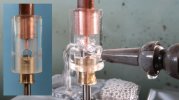
The tungsten copper seen at top is the electrode, the hardened HSS axle material used is at the bottom.
The perspex tube is fixed to the copper electrode. As the electrode oscillates up and down, the perspex slides on the brass bush mounted on the axle. This bush keeps the pointy end of the copper centralised to the axle.
The perspex tube used here is to avoid filling the machine's 200 litre tank with EDM oil (when the front door seals to the tank looked suspect).
The nozzle at right squirts EDM oil through the side hole of the perspex - submerging the tiny area of cutting action with oil - as would happen if the tank was also filled.

The tungsten copper seen at top is the electrode, the hardened HSS axle material used is at the bottom.
The perspex tube is fixed to the copper electrode. As the electrode oscillates up and down, the perspex slides on the brass bush mounted on the axle. This bush keeps the pointy end of the copper centralised to the axle.
The perspex tube used here is to avoid filling the machine's 200 litre tank with EDM oil (when the front door seals to the tank looked suspect).
The nozzle at right squirts EDM oil through the side hole of the perspex - submerging the tiny area of cutting action with oil - as would happen if the tank was also filled.
Mike W
Western Thunderer
Distant memory - Brian Rogers of Ultrascale had a spark erosion machine 40 years ago which he used to copy his circa 1/4 scale rail chair and produce a die suitable for plastic injection moulding them in 4mm. I never saw it. Maybe his wheel centres were made the same way?
Mike
Mike
Arun Sharma
Western Thunderer
Whilst not perhaps wholly relevant, it is now possible to produce commercially, for limited length injection moulded runs, moulding tools [complete with liquid cooling channels] that are wholly 3D printed in hard plastic materials. Thus, no longer does a tool have to be made of metal or produced by spark erosion - all of which leads to saving significant quantities of time, money and expertise. It is now possible to economically produce short runs of injection moulded loco bodies - measured in scores rather than tens of thousands.
Brian McKenzie
Western Thunderer
I also (for a time) injection moulded wagon and locomotive wheel centres using my own produced steel dies and machine. The split spoke wagon wheels were moulded in glass filled acetal, and to get the mould to fill properly, it needed to have 2 x 500 watt cartridge elements added, then water cooling.
In my amateurish setup, it was necessary to heat the acetal to its upper limit, and on one very unpleasant occasion, when it became overheated, the gas given off shut my body down and I flopped outside and lay on the grass to recover.
Other wheels were moulded in the more easily used polythene - for later burning out in the 'lost-wax' process to get brass castings.
It's still early days for 3D printed moulds to achieve anything like the crisply detailed locomotive bodies that we are accustomed to. However, a quite exciting 3D printed use is for sand moulds for casting parts for full-size locomotive builds and repairs, removing the need for conventional patterns and even those lately printed in polystyrene.
Returning to EDM, this process is probably of very limited value to the modeller as electrode wear is horrendous - if making parts in non ferrous metal. Electrode wear is much reduced when burning steel, but it's fairly typical for say four electrodes to be used to rough out and fine finish a cavity.
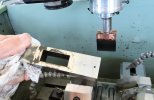
The previously rounded corners of this opening in a block of steel (an O gauge loco test block chassis) were squared out by the suspended copper block electrode - now blackened and partly worn from the process.
In my amateurish setup, it was necessary to heat the acetal to its upper limit, and on one very unpleasant occasion, when it became overheated, the gas given off shut my body down and I flopped outside and lay on the grass to recover.
Other wheels were moulded in the more easily used polythene - for later burning out in the 'lost-wax' process to get brass castings.
It's still early days for 3D printed moulds to achieve anything like the crisply detailed locomotive bodies that we are accustomed to. However, a quite exciting 3D printed use is for sand moulds for casting parts for full-size locomotive builds and repairs, removing the need for conventional patterns and even those lately printed in polystyrene.
Returning to EDM, this process is probably of very limited value to the modeller as electrode wear is horrendous - if making parts in non ferrous metal. Electrode wear is much reduced when burning steel, but it's fairly typical for say four electrodes to be used to rough out and fine finish a cavity.

The previously rounded corners of this opening in a block of steel (an O gauge loco test block chassis) were squared out by the suspended copper block electrode - now blackened and partly worn from the process.
I shall have to show it to the latest crop of engineering graduates. The sad thing is, they come out of uni now with no idea about how anything is made, so un-makeable designs are pretty much par for the course. And now 3D printing has come along, they are designing things that can't be 3D printed!The designer bent across his board,
Wonderful things in his head were stored,
.......
He look again and cried, "At last!
Sucess is mine, it can't even be cast."
I’ve no idea who wrote this, I first saw it in Boston Lodge tea room as a very junior fireman in about 1973 or 1974.
That's a very neat setup. I bought mine with the main intention of making embossing dies for tinplate, but the other thing I am about to try is cutting out the spokes in handwheel blanks, using copper tube with spoke slots cross-cut with a jeweller's saw.I have an EDM sinker in my hobby workshop - but have only used it a couple of times. Once for squaring out a cavity for a motor/gearbox, and for putting dummy
The tungsten copper seen at top is the electrode, the hardened HSS axle material used is at the bottom.
The perspex tube is fixed to the copper electrode. As the electrode oscillates up and down, the perspex slides on the brass bush mounted on the axle. This bush keeps the pointy end of the copper centralised to the axle.
The perspex tube used here is to avoid filling the machine's 200 litre tank with EDM oil (when the front door seals to the tank looked suspect).
The nozzle at right squirts EDM oil through the side hole of the perspex - submerging the tiny area of cutting action with oil - as would happen if the tank was also filled.
What model EDM machine do you have?
One thing I thought of with EDM and 3D printing is that now you can do 8000K 3D prints in lost casting wax, you can make a clutch of brass or bronze lost wax castings, then use them as electrodes for the EDM with enough to make up for wear. It's just an idea at this stage.I also (for a time) injection moulded wagon and locomotive wheel centres using my own produced steel dies and machine. The split spoke wagon wheels were moulded in glass filled acetal, and to get the mould to fill properly, it needed to have 2 x 500 watt cartridge elements added, then water cooling.
In my amateurish setup, it was necessary to heat the acetal to its upper limit, and on one very unpleasant occasion, when it became overheated, the gas given off shut my body down and I flopped outside and lay on the grass to recover.
Other wheels were moulded in the more easily used polythene - for later burning out in the 'lost-wax' process to get brass castings.
It's still early days for 3D printed moulds to achieve anything like the crisply detailed locomotive bodies that we are accustomed to. However, a quite exciting 3D printed use is for sand moulds for casting parts for full-size locomotive builds and repairs, removing the need for conventional patterns and even those lately printed in polystyrene.
Returning to EDM, this process is probably of very limited value to the modeller as electrode wear is horrendous - if making parts in non ferrous metal. Electrode wear is much reduced when burning steel, but it's fairly typical for say four electrodes to be used to rough out and fine finish a cavity.
View attachment 206530
The previously rounded corners of this opening in a block of steel (an O gauge loco test block chassis) were squared out by the suspended copper block electrode - now blackened and partly worn from the process.
That is definitely interesting, I would like to see an example. It does potentially limit one to the lower temp plastics though. Definite possibilities for me but the majority of stuff I do is in metal so pressing, coining and die casting are my major interest areas, hence Mr Sparky still fills a need for me.Whilst not perhaps wholly relevant, it is now possible to produce commercially, for limited length injection moulded runs, moulding tools [complete with liquid cooling channels] that are wholly 3D printed in hard plastic materials. Thus, no longer does a tool have to be made of metal or produced by spark erosion - all of which leads to saving significant quantities of time, money and expertise. It is now possible to economically produce short runs of injection moulded loco bodies - measured in scores rather than tens of thousands.
I have seen some very neat small injection moulding machines on Youtube, but I can't afford one and don't have the throughput to justify it. A homemade one based on a hand press might be worth cobbling up though.
Brian McKenzie
Western Thunderer
That's a very neat setup. I bought mine with the main intention of making embossing dies for tinplate,
Wouldn't embossing dies be made more easily by using a milling machine, or by a lamination of steel plates? Presumably, electrodes would need to be milled first, so why do the extra unnecessary step - which end result wouldn't offer as good a finish?
The window frames in this cab side Rivets were pressed using simple tools straight off the milling machine.
What model EDM machine do you have?
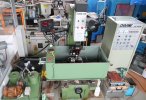
One thing I thought of with EDM and 3D printing is that now you can do 8000K 3D prints in lost casting wax, you can make a clutch of brass or bronze lost wax castings, then use them as electrodes for the EDM with enough to make up for wear. It's just an idea at this stage.
Here again, better just to have the waxes used directly for lost-wax cast brass. This then caters for proper oval or H section spokes etc, which otherwise would need more complex moulds if EDM'd. In any case, if making moulds, properly milled cavities would be vastly superior.
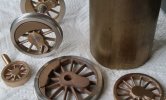
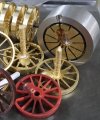
Brass wheel centres cast from injection moulded polythene.
Be aware that ownership of an Electrical Discharge Machine is no sinecure to model production - without the backing of a vast amount of supporting tools, machines and equipment. I bought mine, and an Agie some years ago with the intention of eventually moulding a few model items of interest. Several moulds were made, but this constantly required upgrading of facilities to combat new challenges.
Meanwhile, a new real world work career beckoned and this took my full attention for the next twenty years. Now-a-days EDM sinking is a much less used process, surpassed by high speed machining techniques (light cuts performed at fast feed rates). This doesn't apply to EDM wire-cut machines which are a fabulous piece of kit.
I'd be very pleased to see something you eventually produce with your machine.
-Brian McK.
simond
Western Thunderer
I pondered wire cutting, I can’t immediately see what you couldn’t do (modelling-wise) by waterjet or metal cutting laser.
In previous employment, we used wire cutting to create metal cutting tools for stamped and fine blanked parts including gear segments.
This was one of mine, Rover 200/400 and Honda Civic, went into production about 1991 or 2. The module & radius of the gear segment was different for the electric version, the motor pinion had 10 teeth, the manual was 6. Made in Sully-sur-Loire in France, where the company introduced one of the first robotic flexible manufacturing lines, with vision system. It was an impressive set up, but the robot carts soon went!
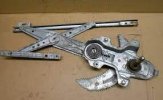
In previous employment, we used wire cutting to create metal cutting tools for stamped and fine blanked parts including gear segments.
This was one of mine, Rover 200/400 and Honda Civic, went into production about 1991 or 2. The module & radius of the gear segment was different for the electric version, the motor pinion had 10 teeth, the manual was 6. Made in Sully-sur-Loire in France, where the company introduced one of the first robotic flexible manufacturing lines, with vision system. It was an impressive set up, but the robot carts soon went!

Wouldn't embossing dies be made more easily by using a milling machine, or by a lamination of steel plates? Presumably, electrodes would need to be milled first, so why do the extra unnecessary step - which end result wouldn't offer as good a finish?
The window frames in this cab side Rivets were pressed using simple tools straight off the milling machine.
Here again, better just to have the waxes used directly for lost-wax cast brass. This then caters for proper oval or H section spokes etc, which otherwise would need more complex moulds if EDM'd. In any case, if making moulds, properly milled cavities would be vastly superior.
Brass wheel centres cast from injection moulded polythene.
I'd be very pleased to see something you eventually produce with your machine.
-Brian McK.
Well, there are a couple of questions there. Re embossing dies it depends on the features you need to have on both sides of the die set. If you have a relative paucity of features and both raised (ie rivet heads, beading, window frames) and sunken (ie panel gaps) features then machining both sides makes the most sense, and I have stuff done that way in that sort of case. If all your raised features are on one side, and you can machine a block of carbon on a small 3-axis machine and don't mind (or properly manage) the mess, you can cut the negative into the electrode and then sink into the male press tool. So its quicker and easier than machining two pieces of tool steel. You don't get much electrode wear on the cut because the important features are uncut material so one or two electrodes for roughing and finishing are enough. Then, you can make the female tool by pressing the male tool into a softer piece of steel (if you have access to a 500 ton press) to produce a perfectly matching pair of coining dies. In that particular case it is much cheaper and quicker.
Re moulding, what you have done there is very impressive. Could you do the same thing by 3D printing waxes with dental casting resin in an 8k or 12k 3d printer now? I reckon you might these days, they are improving so quickly. Re the wheel centres, what do you do for insulation?
Here's a pic of my machine, and some tools and parts made from it. I didn't make the tools apart from the frame folding tool, just designed them.
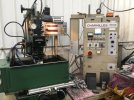
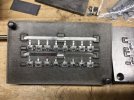
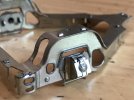
Stoke5D
Western Thunderer
I'vr used EDM in the dim distant past during my Graduate industrial training but it was only to machine tooling (eg. dies) that couldn't easily, or at all, be machined via other means. So very limited uses for us I think. The manufacture of moulds or similar tooling that couldn't be machined conventionally would be it.
Bear in mind it's also quite hard to get exactly what you want from the end-product due to the interaction between the settings of the machine, dimensions and material of the tooling and workpiece but not least because the tooling is also being eroded as you use it.
Bear in mind it's also quite hard to get exactly what you want from the end-product due to the interaction between the settings of the machine, dimensions and material of the tooling and workpiece but not least because the tooling is also being eroded as you use it.
Brian McKenzie
Western Thunderer
Wowee! The tabbed construction of the trailing truck is a very interesting piece of work. What scale is this - and is it for an Australian prototype?
> . . . you can machine a block of carbon on a small 3-axis machine and don't mind (or properly manage) the mess. . . .
Yes, that presents a dilemma. I've thus far not machined graphite (and reluctant to) because of the mess, and the danger it presents to working surfaces and parts etc., not having anything like a full extraction/containment system.
Alas, don't know anyone with a 500 ton press that would want to bother with model bits. My 10 tons at home isn't any good for coining (a method that was popular in 1980s USA). For press tools, I've mostly used gauge plate, then hardened it. A drawback is that gauge plate shrinks during hardening - so more consideration has to be given to finish grinding it - if needed for precision fits rather than cosmetics.
Re 3D printed waxes: I have used many prints in wax (genuine casting wax that is) for lost-wax casting in brass, nickel-silver and in silver. For a time, many of the 3D printed resins were not ideal - either leaving ash residue behind, or unliked by the casting people because of the different and longer burn-out cycle time required. However, this has, or is changing. A colleague is getting superior castings now via his own high resolution resin prints, than I've received from those operating e.g. Solidscape and ProJet MJP 2500 wax printing machines.
> Re the wheel centres, what do you do for insulation?
Nearly all get insulated at the rim with an epoxy infill. A ring of ordinary copy paper soaked in Araldite also works well. All tyres have a front lip that conceals this.
That's a good response- thanks!
It's O gauge, Australian prototype, S class pacific in 0.016" tinplate. The scale I use is 1:45.5, which isn't strict scale for O gauge especially a broad gauge prototype but keeps the Victorian Railways loading gauge consistent with UK, US, European er models? Toys? Hmmm. Talking Bassett Lowke, Marklin etc here. It's a Commonwealth trailing truck, you can see more of the loco here: S class tooling
With coining, I find I can coin a fair few things with a garage hydraulic press. I have a chinese one with an electric pump that will do 55 tonnes. You can form the softer tool or intensifier with that if the part is small, say under 3 or 4 square inches, above that I have to borrow the 500 tonner (Or drive 300 miles to use a 1000 ton one when its indisposed) although it probably rarely gets up to 500T except on really big things. Once the tool is formed you obviously don't need anything like that to press parts, 20 tonnes usually adequate for what I do.
Re wheels, I haven't made insulated wheels yet, but I can see that happening potentially. I really like and use Walsall wheels but I'm not keen on their spoke insulation.
It's O gauge, Australian prototype, S class pacific in 0.016" tinplate. The scale I use is 1:45.5, which isn't strict scale for O gauge especially a broad gauge prototype but keeps the Victorian Railways loading gauge consistent with UK, US, European er models? Toys? Hmmm. Talking Bassett Lowke, Marklin etc here. It's a Commonwealth trailing truck, you can see more of the loco here: S class tooling
With coining, I find I can coin a fair few things with a garage hydraulic press. I have a chinese one with an electric pump that will do 55 tonnes. You can form the softer tool or intensifier with that if the part is small, say under 3 or 4 square inches, above that I have to borrow the 500 tonner (Or drive 300 miles to use a 1000 ton one when its indisposed) although it probably rarely gets up to 500T except on really big things. Once the tool is formed you obviously don't need anything like that to press parts, 20 tonnes usually adequate for what I do.
Re wheels, I haven't made insulated wheels yet, but I can see that happening potentially. I really like and use Walsall wheels but I'm not keen on their spoke insulation.
